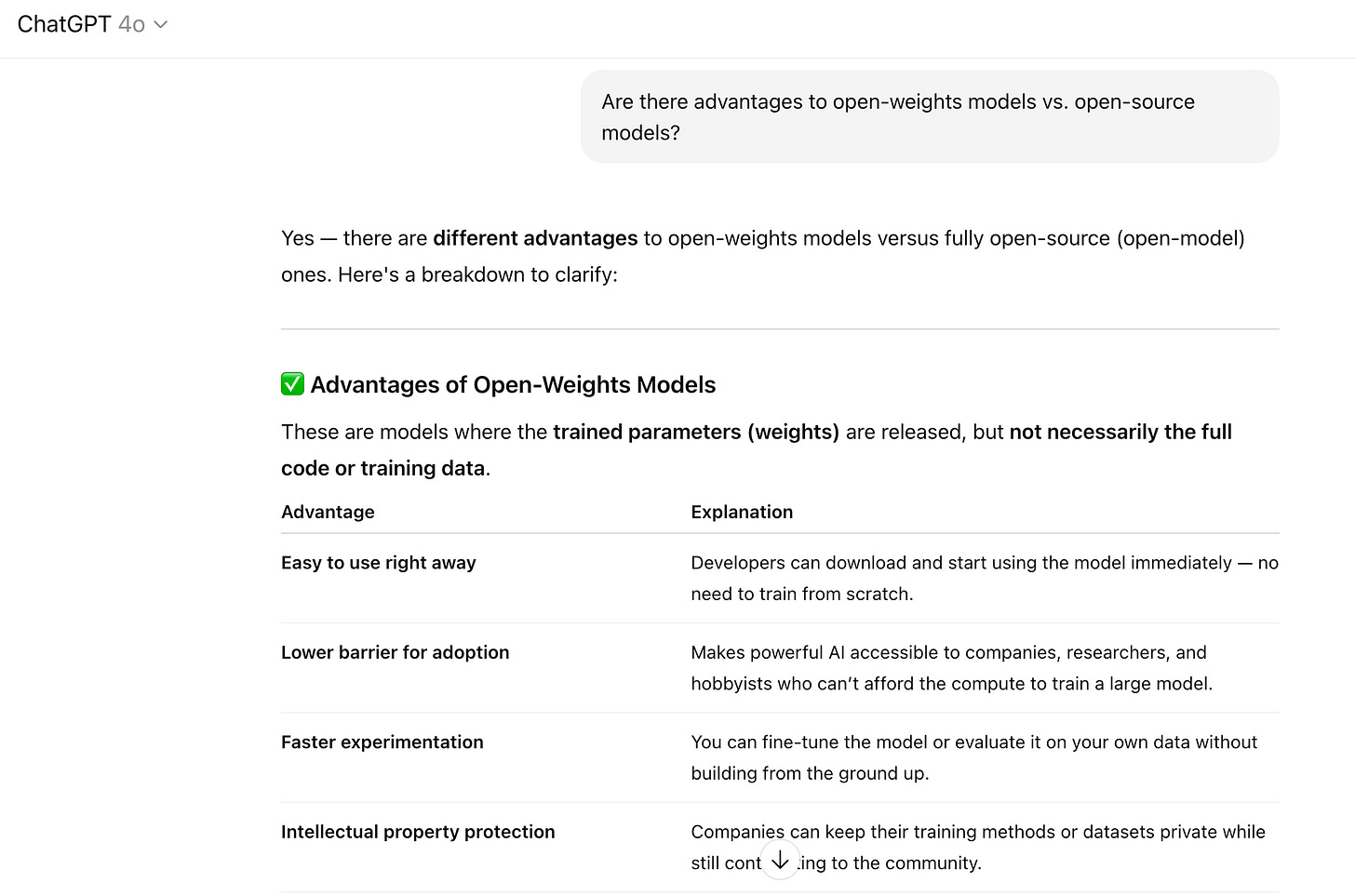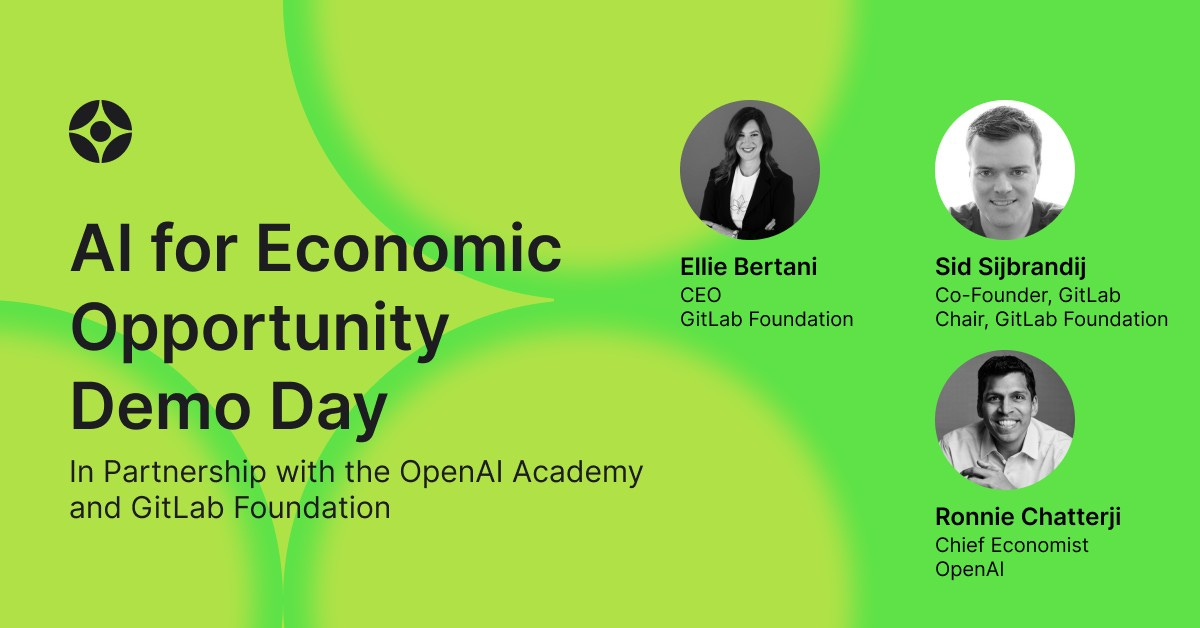Open Weights and Open Gates
AI for DC
Hi
Welcome (back) to The Prompt. AI isn’t well understood, but we learn a lot in our work that can help. In this newsletter, we share some of those learnings with you. If you find them helpful, make sure you’re signed up for the next issue. You have choices here – to receive our weekly US newsletter, our monthly EU newsletter, or if you really want to load up, then both.
[News] Introducing our open weights models
Today, we’re releasing what we believe to be the best and most usable open models in the world—the result of billions of dollars of research, able to run locally on your own computer or phone.
It’s part of our broader effort to help make AI available to the most people possible, not concentrated in the hands of the few. That’s why we’re integrating these open models into both our OpenAI for Countries initiative that helps governments build their own AI infrastructure, and the OpenAI nonprofit's support for groups on the frontlines of their communities.
Geopolitical upside. Open models create a powerful network effect for advancing American-led democratic AI. When many developers use and improve the same tools, every contribution—new integrations, fine-tunes, or performance improvements—benefits the whole community. It’s the same reason that Linux runs a major share of the world’s servers: open-source collaboration ensures that the whole becomes greater than the sum of its parts. Just as science advances through incremental contributions that build toward major breakthroughs, shared AI tools let the best ideas emerge faster and reach more people.
The country that produces the most widely adopted AI models shapes the global standards that others follow. Choosing to build on models developed in the US is effectively a bet on American innovation and values. In the Intelligence Age, AI models are a form of soft power: when governments and companies adopt US-origin models, they’re choosing an ecosystem rooted in reliability, transparency, and democratic norms.
Open models economics. But the case for open source extends beyond individual organizations, creating positive externalities—benefits enjoyed broadly by society rather than captured solely by the original creator. A recent Harvard study estimated that the demand-side value of all open-source software is nearly $9 trillion. By significantly lowering upfront costs and leveraging collective creativity, open-source solutions remove barriers to adoption and enable rapid and widespread use of new technologies.
In short, certain segments of the market will find open-weights models more accessible, and those models will speed innovation by enabling greater transparency and faster experimentation, which means more products will get to market faster and find their product-market fit. And that’s where value is unlocked.
[Prompt] Open weights vs. open source
What’s the difference between open-weights models and open-source ones? And what are the advantages to open weights? Ask ChatGPT.
[Insight] Where we stand on AI competition
A US federal court last fall condemned Google’s illegal search monopoly, and will soon issue a decision on how to remediate that long-standing monopoly. But the remedy is about more than the history of online search and unwinding Google’s stranglehold – it’s also about stopping Google from using its monopoly in search to choke off competition in AI.
As more people adopt AI, Google continues to dictate terms around access to data and create distribution bottlenecks, including access to prime real estate on mobile devices, browsers, and at the top of its search results. The next generation of technologies we use – and whether or not their benefits will be broadly distributed or concentrated in the hands of a few (a movie we’ve seen before) – will be shaped by the court’s decision and how policymakers approach this issue.
In the remedy phase of the trial last spring, a witness from OpenAI told the court that:
Android and default Search agreements block distribution channels, locking out rival AI assistants and other offerings before users even power on a device.
Search and access to real-time information are critical inputs to AI products. Google’s content silos and ecosystem control leave smaller AI and search developers scrambling for scraps while Google stockpiles the raw materials that power these services.
Absent intervention, Google’s decades-old playbook – dictate default settings, impede choice, and leverage users’ data across products – will carry into the future, tilting the forming AI landscape against smaller innovative startups in the same way Google has blocked meaningful search competition. That would be a senseless brake on American innovation and do a lot of harm to America’s economy. It would concentrate AI’s potential gains in the hands of a legacy Big Tech player rather than democratizing it in ways that give people and businesses real choice and help innovative entrants to build for America’s future.
A plan for robust AI competition. The remedies for Google’s practices could apply more broadly, too. The following policy proposals are a roadmap to a more dynamic AI-driven economy, enabling the industry to support independent innovators who can compete effectively with entrenched monopolies. This is crucial to ensuring that American technology maintains its global edge and that democratic AI principles – where people decide how they want to use AI – will drive American progress at home and around the world.
Here’s what we suggest:
Ensure open distribution. Defaults matter and exclusivity impedes choice. Google has paid tens of billions of dollars to lock in default search status on phones and browsers – and it’s now pursuing the same strategy for AI. The court should prohibit a monopolist like Google from having exclusive defaults, pre-installation, and self-preferencing deals on operating systems, browsers, mobile, and cloud ecosystems. People and business customers – not Big Tech – should decide which AI services appear on their home screen, answer their questions, or help them sift through emails and documents.
Open up data. The lifeblood of large-scale AI is access to data. Legacy platforms should either share data from large unrelated products, or stop using it for training their own AI services alone. Data hoarding hurts smaller competitors and seems hard to justify when the company acquired this user data via unrelated legacy services.
Reintroduce flexibility. A healthy, competitive marketplace requires that a wider range of assistants, models, and plug-ins work together seamlessly. Incumbent platforms should enable standardized APIs that let any AI model use data or access necessary data, plug into apps, and hand off tasks without friction. Think of it as a USB port for intelligence: one port that is accessible to any number of suppliers – small or large, new or well-established.
The stakes. If we repeat the mistakes of the early 2000s, when Google leveraged its search dominance into an advertising empire and stunted rivals before they could breathe, we’ll squander the current surge of AI innovation and opportunity. Allowing an incumbent to dictate the terms of distribution, data access, and interoperability will smother the next wave of new tech breakthroughs and squash their disruptive potential to offer many more competitive options and whole new paradigms.
With the imminent Google decision and ongoing discussions about how to promote AI, policymakers have a rare chance to act with foresight: eliminate exclusionary defaults, open data, and require interfaces that give users real choice. Do that, and the US won’t just have one AI champion; it will have an ecosystem of them – competing vigorously, advancing the frontier, and delivering better tools to every household and business. That’s how American AI wins this global race.
[About] OpenAI Forum
Explore past and upcoming programming by and for our community of more than 30,000 AI experts and enthusiasts from across tech, science, medicine, education and government, among other fields.
6:00 PM – 8:30 PM ET on Aug 11
[Disclosure]
Graphics created by Base Three using ChatGPT.









